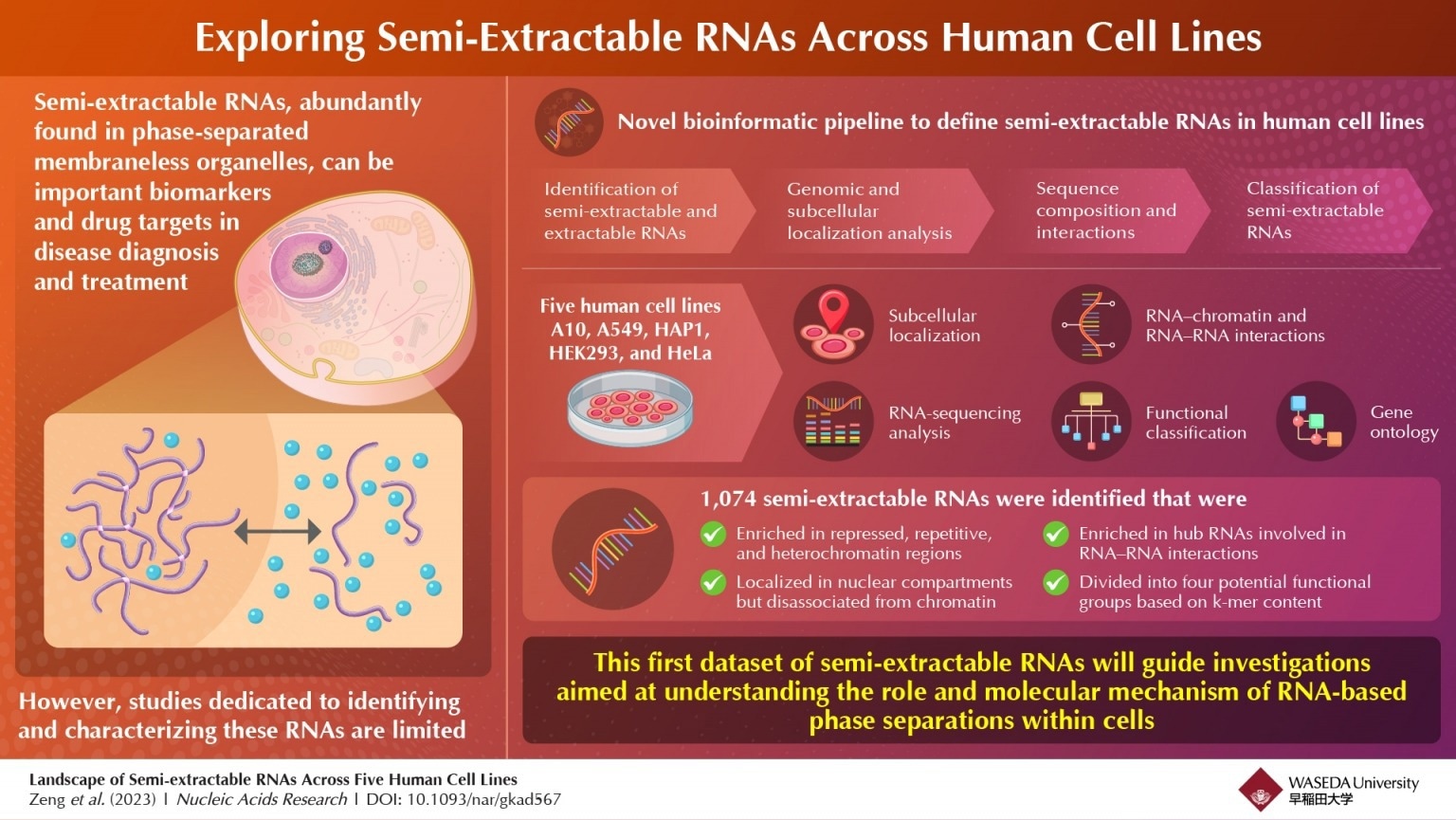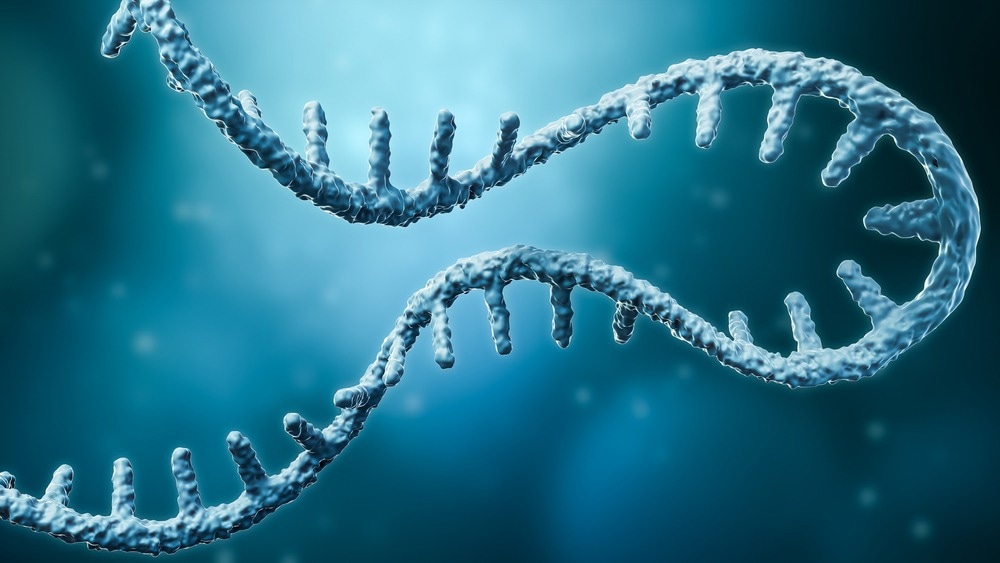Reviewed by Danielle Ellis, B.Sc.Jul 19 2023
High levels of semi-extractable RNAs are present in membraneless organelles in cells, and these RNAs could one day serve as biomarkers or therapeutic targets. These RNAs have, however, only been partially identified and described.

Image Credit: Waseda University
Now, Japanese researchers have created a unique bioinformatic pipeline to define and examine semi-extractable RNAs, which has allowed them to identify over 1000 RNAs involved in the development of membraneless organelles. Future research into RNA-centric phase separations is made possible by the findings of this study.
The biological process of liquid-liquid phase separation (LLPS), commonly referred to as “biomolecular condensates,” results in membraneless organelles (MLOs). MLOs are extremely dynamic entities that include nucleic acids and proteins.
Although the function of proteins in LLPS has been extensively studied, there is a growing interest in the scientific community to comprehend the function of RNAs—the nucleic acids in charge of numerous biological processes like the coding, decoding, regulation, and expression of genes—in phase separation. RNAs ultimately regulate the expression of genes and produce proteins.
Recent research has shown that MLOs are rich in RNAs that are difficult to extract using standard techniques but can be successfully retrieved using more advanced techniques like heating and needle shearing, a quality known as semi-extractability.

Image Credit: MattL_Images/Shutterstock.com
In the diagnosis and treatment of diseases, these semi-extractable RNAs can serve as significant biomarkers and therapeutic targets. But only a small number of studies have been able to locate and describe these RNAs.
A novel bioinformatic pipeline has been created by Dr Chao Zeng, an assistant professor at Waseda University, in conjunction with Dr Michiaki Hamada, Dr Takeshi Chujo, and Dr Tetsuro Hirose from Kumamoto University and Osaka University to fill this gap by defining semi-extractable RNAs in a variety of human cell lines.
On July 19th, 2023, their findings were released in the journal Nucleic Acids Research.
A10, A549, HEK293, HeLa, and HAP1 cells were among the five human cell lines on which the scientists did cellular RNA extraction and sequencing. They used a variety of computational methods to continue studying the RNA sequencing data.
Between samples extracted using the standard RNA extraction approach and the enhanced extraction method, a differential expression analysis was carried out.
The researchers discovered RNA transcripts in all five cell lines that were consistently semi-extractable. To investigate potential parameters impacting semi-extractability, repeat density, and sequence motif analysis were also performed.
Additionally, the researchers functionally categorized semi-extractable RNAs based on their k-mer content by performing k-mer analysis with the SEEKR method.
Using the newly developed bioinformatic analysis pipeline, we examined original experimental data from cultured human cell types and successfully identified and characterized 1,074 semi-extractable RNAs potentially involved in the formation of phase-separated membraneless organelles.”
Chao Zeng, Assistant Professor, Waseda University
After examining the distribution of semi-extractable RNAs in chromatin and throughout the cell, the scientists discovered that these RNAs were abundant in repressed and repetitive heterochromatin (darkly stained regions), particularly in Polycomb-repressed regions.
The RNAs within the cells were gathered in the nucleus, including the nucleolus, but were not connected to the chromatin.
The researchers also hypothesized that the semi-extractable RNAs would serve as a platform for interacting with other RNAs.
They examined semi-extractable RNAs with over 600 hub RNAs that formed protein-mediated RNA-RNA interactions with several other RNAs to confirm their theory. They discovered that RNA-RNA connections formed by semi-extractable RNAs did indeed function as hubs and were crucial.
A further in-depth examination of semi-extractable RNA showed that RNA-binding proteins strongly favor binding to the AU-rich portions of the RNAs.
Semi-extractable RNAs had a concentration of AU regions at the 5’ end, indicating possible involvement in yet-to-be-identified activities, in contrast to messenger RNAs, which often exhibit AU-rich areas at the 3’ end that govern RNA stability.
The finding offers a crucial resource for researching RNA-based phase separations: the first collection of semi-extractable RNAs across human cell lines.
Future integration of semi-extractable RNAs with RNA interaction studies will provide insights into the molecular mechanisms underlying RNA-induced phase separation in cells.”
Michiaki Hamada, Professor, Waseda University
The study’s results open up new avenues for investigation into the role of RNA in biological processes, including cancer initiation and progression, viral RNA degradation, and cellular stress responses, and they could impact the creation of cancer and infectious disease therapy approaches.
Source:
Journal reference:
Zeng, C., et al. (2023). Landscape of semi-extractable RNAs across five human cell lines. Nucleic Acids Research. doi.org/10.1093/nar/gkad567